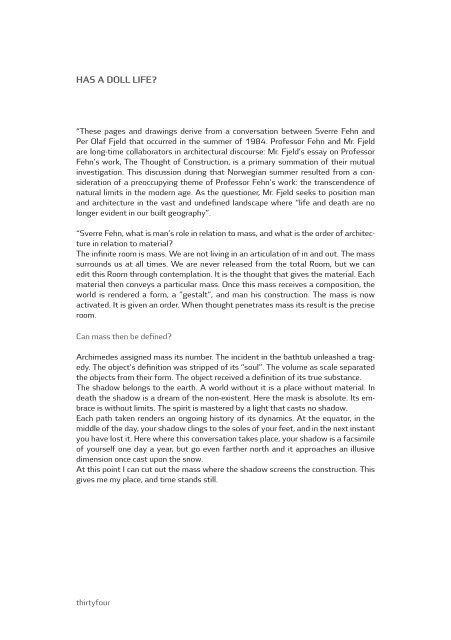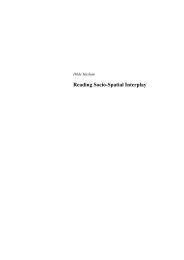STUDIOWORK - Arkitektur- og designhøgskolen i Oslo - AHO
STUDIOWORK - Arkitektur- og designhøgskolen i Oslo - AHO
STUDIOWORK - Arkitektur- og designhøgskolen i Oslo - AHO
- No tags were found...
You also want an ePaper? Increase the reach of your titles
YUMPU automatically turns print PDFs into web optimized ePapers that Google loves.
HAS A DOLL LIFE?“These pages and drawings derive from a conversation between Sverre Fehn andPer Olaf Fjeld that occurred in the summer of 1984. Professor Fehn and Mr. Fjeldare long-time collaborators in architectural discourse: Mr. Fjeld’s essay on ProfessorFehn’s work, The Thought of Construction, is a primary summation of their mutualinvestigation. This discussion during that Norwegian summer resulted from a considerationof a preoccupying theme of Professor Fehn’s work: the transcendence ofnatural limits in the modern age. As the questioner, Mr. Fjeld seeks to position manand architecture in the vast and undefined landscape where “life and death are nolonger evident in our built ge<strong>og</strong>raphy”.“Sverre Fehn, what is man’s role in relation to mass, and what is the order of architecturein relation to material?The infinite room is mass. We are not living in an articulation of in and out. The masssurrounds us at all times. We are never released from the total Room, but we canedit this Room through contemplation. It is the thought that gives the material. Eachmaterial then conveys a particular mass. Once this mass receives a composition, theworld is rendered a form, a ”gestalt”, and man his construction. The mass is nowactivated. It is given an order. When thought penetrates mass its result is the preciseroom.Can mass then be defined?Archimedes assigned mass its number. The incident in the bathtub unleashed a tragedy.The object’s definition was stripped of its “soul”. The volume as scale separatedthe objects from their form. The object received a definition of its true substance.The shadow belongs to the earth. A world without it is a place without material. Indeath the shadow is a dream of the non-existent. Here the mask is absolute. Its embraceis without limits. The spirit is mastered by a light that casts no shadow.Each path taken renders an ongoing history of its dynamics. At the equator, in themiddle of the day, your shadow clings to the soles of your feet, and in the next instantyou have lost it. Here where this conversation takes place, your shadow is a facsimileof yourself one day a year, but go even farther north and it approaches an illusivedimension once cast upon the snow.At this point I can cut out the mass where the shadow screens the construction. Thisgives me my place, and time stands still.So everything belongs to the earth?The drawings on earth are the result of a convergence of mass. A cavity fills withwater that again draws its line on the earth’s surface. If we replace the water withthought, the line becomes a construction man offers earth. The nature of architectureis to discover this thought-construction.The cave dweller is unable to free himself from the mass, but lives in his own shadowas a token of place. He replaces the earth’s mass with the material that gave himboth darkness and the undefined room. The cave adds to the heaven’s volume withoutrelinquishing its shadow. The opening remains the only respite. Outside, the treemobilizes light and casts its shadow on earth, a realization of place. You are part ofanother’s shadow, and you are no longer alone. It is here the story is told.Do you mean the history of time?Man’s first signs were to move the mass. The stone’s precise placement on earthcarried a message. Man could wander between arranged masses, as the dial<strong>og</strong>ue belongedto the moment. The stone and its place were a point on earth that conveyeda mass inhabited by spirit. Later history recapitulated and lost was the conversationwith the night and its stars. Victor Hugo, the French author, remarked once that withthe advent of printing the art of building vanished. The written sign released historyfrom place. The interpretation was not tied to its surroundings. The book read byall no longer gave the ordained stone the same immediate importance. The dial<strong>og</strong>uebetween man and nature ceased. The book, it is true, transmitted the thought of thestone, but freed from its mass. The concept of time is in disorder. The book is everlasting,as it is reprinted, protected, moved, and stored. By forsaking the mass, its historyis free from time. The following day the stone casts its shadow, but the book is alreadyinterpreted. Time and place must follow one another. Time in itself is a material.So time is mass in motion?Man has always searched for masses in motion. The dam tames the river. This wallforced into the landscape imprisons energy, and when the battle is over, the heavensare given a new mirror.The sail, a collector of winds, sets the hull in motion and perforates this luminousmass. The boat defines the mass and gives movement its room-concept. A place inmovement is the room of the moment. The objects moving in mass give it an intimacy.You are part of the material. Man’s dream of the infinite Room is so beautifully expressedthrough Aladdin carried by the jinneé of the magic lamp hovering over the earth.thirtyfourthirtyfive
















